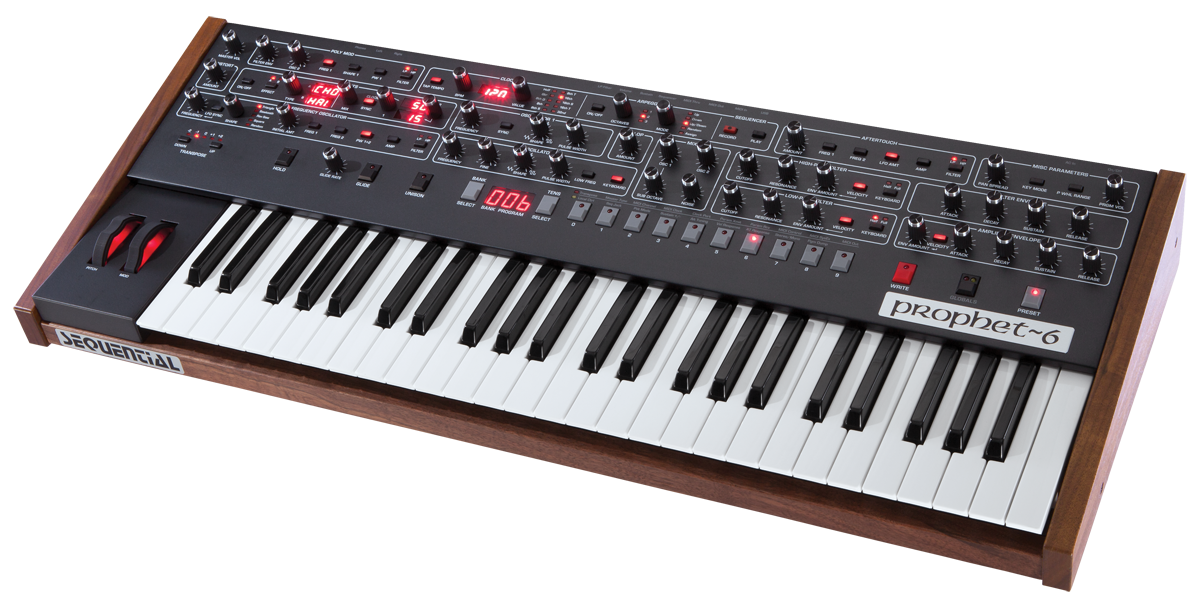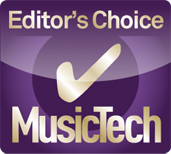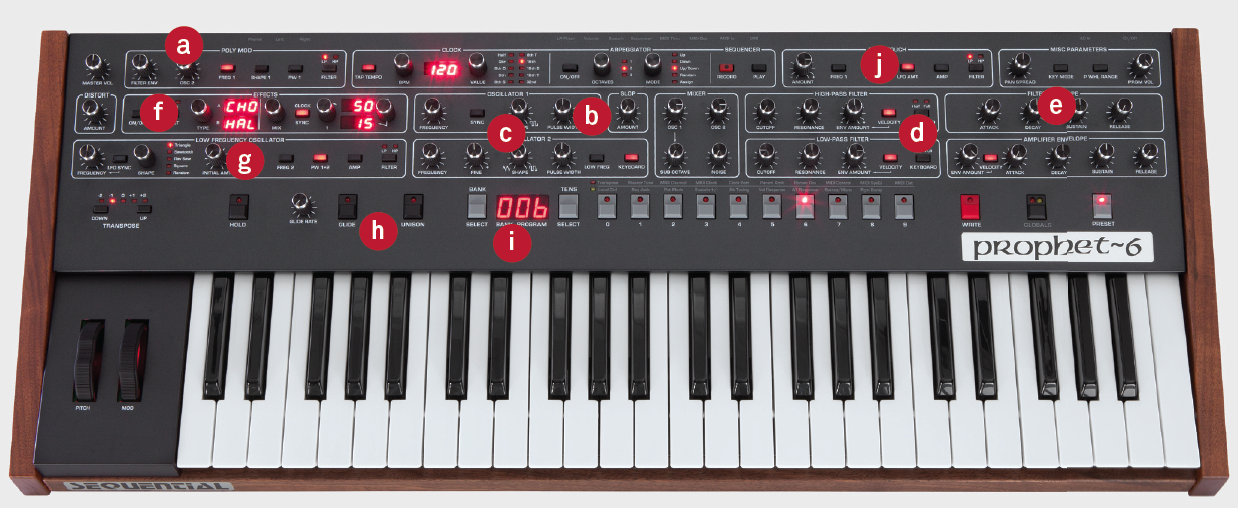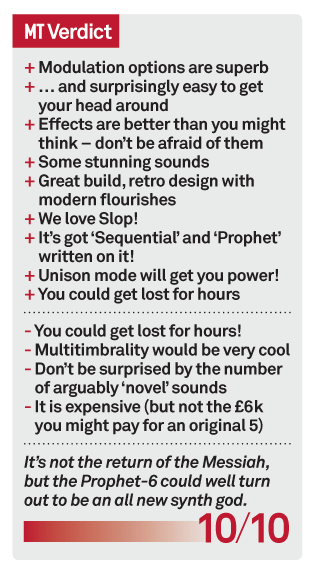Sequential Prophet-6 Review
It’s a story to melt your hearts and a synth to melt your ears. Andy Jones finally gets his hands on the synth he’s always wanted, in the shape of the Sequential – yes that name is back – Prophet-6… Details Price $2,800 Contact Via website Web www.davesmithinstruments.com The story behind the birth of […]

It’s a story to melt your hearts and a synth to melt your ears. Andy Jones finally gets his hands on the synth he’s always wanted, in the shape of the Sequential – yes that name is back – Prophet-6…



Details
Price $2,800
Contact Via website
Web www.davesmithinstruments.com
![]()
The story behind the birth of the Prophet-6 almost eclipses anything that the instrument itself can possibly deliver. It’s one that should leave you feeling good, that humanity can be good after all.
The history of the analogue synthesiser is littered with great engineers and visionaries: Bob Moog, Tom Oberheim, Alan R Pearlman and Dave Smith to name but four, with the Minimoog, OB, ARP Odyssey and Prophet-5 synths being four iconic models produced by them. At some point in their histories, though, all four pioneers have lost the rights to their own brand names. This happened for various reasons, many of which were down to the march of technology.
In some cases, they have won them back, though, to go on and produce some incredible new versions of their classic synths. In Dave Smith’s case, Sequential was the name he lost and the one behind the Prophet-5 (aka the synth I always wanted when I was growing up).
He gave up the rights to the name to Yamaha in 1987, but in an extraordinary move, Roland founder Ikutaro Kakehashi – one of the main men behind the MIDI standard – personally asked Yamaha to return the rights of the Sequential name to Smith. “I feel that it’s important to get rid of unnecessary conflict among electronic musical instrument companies,” said Kakehashi.
Incredibly, Yamaha president Takuya Nakata agreed, much to Smith’s joy. “To say that I’m grateful would be putting it mildly. Generosity at this level is almost unheard of.”
With the name back, Smith didn’t hang about, and decided that the best way to celebrate the return of Sequential would be “by building the most awesome-sounding, modern analog poly synth possible.” The Prophet-6, then, is a tribute to Sequential’s most famous instrument, the Prophet-5.
After such an awesome story – and I’d like to personally thank all of the above people for providing me with such a great and easy introduction to this review – we have the resultant Prophet-6 in for test. So it better be good then, eh? No pressure then Dave…
Is it the new 5?
First up, this isn’t a new Prophet-5, not in the sense of the bolts and all recreations of other studio items we have seen of late – Neumann’s U47 or ARP’s Odyssey anyone?
The 6 is a celebration of the Sequential name reverting to its owner, and not intended as a straight-up recreation of the 5. That would be limiting, especially when Smith wanted to create the ultimate analogue poly synth. He has heaped extras into the 6: a dual effects section, more presets, extra power and a modern edge (USB MIDI – hurrah!) so you can, if you like, think of it as an update. A sequel then? Yes, but is it Aliens or Alien 3?
Alternatives
While I keep banging on about the Prophet-6 not being a Prophet-5 – and then annoyingly making comparisons between the two throughout this review – I’ll list some software Prophet-5 alternatives anyway.
There are a few around, notably the Arturia Prophet VS and the freeware Prophanity, ScP5 and Messiah, although my old favourite Pro53 by Native Instruments is now discontinued. As far as hardware poly synths go, I’ve looked at the Roland JD-XA, which will give you analogue and digital, and as a crossover synth doesn’t really offer the same kind of pure analogue offered by the Prophet-6, but you can use it as a multitimbral synth.
The Elektron Analog Keys is another machine that I have tested and sounds incredible, although is a tough one to get your head around. Even though it’s not polyphonic I also have to mention MT Hardware Instrument Of The Year, the Moog Sub37. Great for big, big sounds…
Overview

a: POLY MOD – Use filter envelope and Osc 2 as your sources and modulate several Osc. 1 parameters here. One of the highlights of the Prophet 5.
b: SLOP!… is a beautiful thing, despite its name. It provides a more random element in fine tuning between all the oscillators. Great when stacking them.
c: OSCILLATORS – Variable waveshape oscillators mean waves that blend between saw, triangle and square rather than set patterns for extra sonic flexibility in your ingredients.
d: FILTERS – One high-pass, and one low-pass filter gives a huge amount of sonic potential and the Velocity control and Keyboard effect are great additions.
e: FILTER ENVELOPE – As well as controlling the filter shape this section can also be used as a modulation source for the Poly Mod section.
f: EFFECTS – Two banks of digital effects can be bypassed, leaving the Prophet-6 purely analogue, but don’t do this as some of them are great…
g: LFO SECTION – Great hands on LFO routing here means that you can modulate oscillators, pulse width, amp and filter at the touch of a button.
h: UNISON – Turn the Prophet-6 into a stunning 12-oscillator mono synth by stacking oscillators per note and using Slop to add some subtle variation between them…
i: PRESETS – Step through the presets by bank or switch in proper old-school clicking buttons. Great!
j: AFTERTOUCH – Variable Aftertouch allows you to change certain parameters by how hard you press the keys, including oscillators, LFO and filters.
Features
Even the filter on the 6 is only described as ‘Prophet-5 like’, so straight-up comparisons are perhaps unfair, but also quite difficult to avoid, especially when the front-panel layouts of the two are so similar, as are – of course – the looks. And in this test I had the chance to play both side by side, so forgive me if the comparisons do slip out. The layout of the 6 is similar, with some sections in the same place as the 5 including Poly Mod, Oscillators, LFO and presets.
The oscillator section has super-wide frequency, variable waveshape oscillators – ‘variable’ meaning that you are not just stuck with square, sawtooth and triangle shapes; you can select everything in between too. The pulse width of each is also adjustable and you also get fine tuning on oscillator 2.
I particularly love the Slop dial, which adds a random tuning element to all voices, offering the ultimate analogue richness and the kind of vintage drifting that we all thought we wanted to get rid of when unreliable analogues went out of fashion!
Oscillator 2 also acts as a low-frequency oscillator and can effectively be used as an additional one on Oscillator 1 using the Poly Mod section. This is one of the big draws of the synth and something which the Prophet 5 became famous for.
You can use Osc 2 and the Filter Envelope as sources – hence the two dials for controlling levels of these – and then the Osc 1 frequency, waveshape and pulse width plus hi- and low-pass frequencies act as destinations. So you get a lot more flexibility in terms of modulation with sections being modulated while modulating other parts, including a dedicated LFO that I’ll now detail.
So Osc 2 can be used as an LFO but this ‘true’ LFO sits at the bottom left of the fascia and can operate with several dedicated parameters. You can switch between five waveforms here and modulate across a wide frequency range, doubling up on some of what I described above. But the real beauty of this LFO is its hands-on, ease of use. Want to modulate Osc 1 or 2? Just press a button! Same with pulse
width, amp and filter – it’s there, in front of you.
Onto the filters, and the Prophet-6 is packing a lot. You get two filters: a 4-pole low pass and 2-pole high pass. They have an envelope section and also the ability to map velocity to filter parameters allowing for some very expressive playing – hitting a key harder, opens up the filter cut off, for example. Finally, here is the Keyboard effect where you can vary the filter cutoff according to the keyboard position for dark squelchy basses and more searing leads.
Unison Mode is very cool. On a standard synth this might let you turn a poly into a mono synth by layering all the oscillators on to one note, thus providing a very ‘big’ mono sound from a poly synth. On the Prophet-6, you can determine how many you want each note to play so you don’t just get a one set of two or six (ie Unison on or off); instead you determine the number. It’s extra flexibility like this that set the 5 apart from other synths and here, combined with Slop to help differentiate and layer oscillators, makes for some huge, stacked 12 oscillator sounds.
The last main feature on the front panel is the Aftertouch section, a very easy to understand and implement area where you assign oscillator, filter, LFO and amp parameters to aftertouch so that pressing keys will change each, variable, ie the harder you press the bigger the change.
Finally, phew, a big, additional section: the effects. You get two banks of digital effects – A and B – that you can add to any sound. These include delay, chorus and reverb and all are digital but, importantly, generated in a separate audio chain to the analogue engine within the Prophet-6. These are, in the main, quite delay-based and some purists will not want to use them so be happy that in Bypass mode the synth remains purely analogue. Don’t be scared to use them, though, as they add a lot to the sound. Talking of which…
The Sound
First impressions were good, but like any relationship you may need to work at it for a little while. Don’t expect this to be some big EDM monster that takes your head off with massive arpeggiations and filter sweeps.
While there are plenty of those in among the 500 presets, this is a more varied bunch of sounds that shows off all sides of the synth. So there are lots of effects –some a little too ‘novel’ for me – and lots of pads, lots of sounds with movement and lots of depth. What stands out – and for the test I was listening with our reference head phones and monitors, before you ask – is the wide dynamic of whatever sound you dial up. Whether it’s just a percussive hit – and yes some presets are just percussive hits – a deep, moving drone, a lead or an arpeggiation, what you select always came across as full, analogue, punchy and, well, real.

Around the back: you get two outs plus headphone USB MIDI, several pedal connections and MIDI. Standard stuff, but USB MIDI is very welcome…
This is partly as we’re talking ‘analogue’ and compared to the digital, enclosed sounds on my DAW there is a difference between the two – and don’t let anyone tell you any different. It might be simply because you believe it must be better, so it becomes better.
But I doubt that because, like my Sub 37, stacking these sounds up in the mix alongside my regular DAW synths – especially in Unison mode and using that Slop dial, or polyphonic chords – well, the Prophet 6 is outstanding. Subtle sometimes, yes, but more often than not, because of that dynamic I discussed, the movement, the extra width or the sheer Slop power, you will just pick it out of a mix and say: ‘that’s the Prophet alright’.
And don’t worry, because for every effect, or unusual hit, there is a mighty pad or one-note tune just around the corner. It’s also worth treating each preset as a starting point. You have 500 user patches to fill and if you let yourself go you could go on lots of sonic journeys – especially with those modulation options – so you might find yourself filling those slots quickly.
I programmed five new sounds in the first hour –unheard of for me!
Conclusion
Overall, Prophet-6 is a fantastic, solid, great sounding and easy (ish!) analogue poly. The original ‘5’ was notable for its extras and the sequel will be noted for many more, and it’s these that set the Prophet-6 apart from other synths: the routing, flexibility, and the sequencer, which I have not had space to discuss.
Getting back to the comparisons, I promised not to make? Like I said, I did play them side by side during the test and the question did enter my head: which would I have given the choice?
After all the build-up, it has to be… the 5(!), but only to sell it for the fortune it is still commanding, buy a Prophet-6 and go on holiday with the balance.
Sadly, that was a fantasy choice, but I will be putting my money where my mouth is and buying a Prophet-6 and realising a 35-year long dream. I’ll consequently be holidaying in a caravan this year, but who cares? I’ll have this with me, one of the brightest stars in a new era of classic synths.

Key Features
● Analogue synth
● 6 voice
● Two oscillators per voice
● 500 presets plus 500 user
● 4-pole LPF inspired by Prophet-5 filter; 2-pole HPF
● 4-octave full-size keys
● Polyphonic step sequencer with up to 64 steps
● Dual digital effects, analogue distortion
● 2x out, MIDI, USB MIDI, h/phone
● Arpeggiator with Up, down, up/down, random, and assign modes
● Weight: 9.5kg
● Size (lxwxh, cm): 81.3 x 32.3 x 11.7


